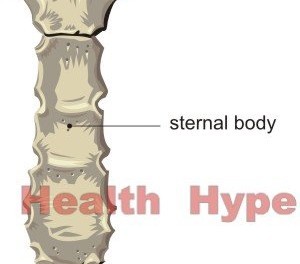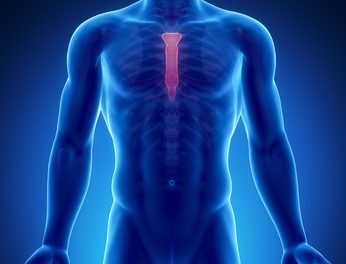Sternum Lumps and Causes of Breastbone Swelling
The sternum or breastbone is the central bone at the front of the chest to which the clavicle (collarbone) and ribs attach. It is an elongated flat bone made up of three parts – manubrium (uppermost part), body of the sternum (longest part in the middle) and the xiphoid process (short pointed part at the bottom). Most of the sternum that can be felt in detail over the skin on the chest wall especially in a thin person.
Swollen Sternum and Breastbone Lumps
The sternum is not a smooth bone – there notches at the top (suprasternal notch) and facets on the sides for the clavicle and ribs to attach to, it also has several transverse ridges on the sternal body. The xiphoid process with its pointed end may at times be felt as a small lump at the bottom of the sternum. Overall however, the sternum sits somewhat flush with the rest of the chest wall.
Sometimes there may be swelling in or over the sternum or isolated lumps (masses) that can be felt or can even be seen over the sternum. These abnormalities need to be investigated as it may be a clinical sign of certain underlying diseases. Lumps on the sternum may not involve the breastbone. It can instead arise from the tissue over the sternum, such as inflamed lymph nodes.
Other Symptoms
In most cases a sternal swelling or mass is not due to any abnormality. Most people become very conscious of the otherwise normal surface anatomy of the sternum usually after an injury or when there is pain. Nevertheless, a sternal swelling or mass should be investigated by a medical practitioner to exclude some of the causes discussed below.

Sternal swelling or a mass may also be accompanied by other symptoms such as :
- Breastbone pain
- Tenderness
- Redness of the skin on the central chest wall
- Warmth of the overlying skin
- Difficulty breathing due to pain with inspiration in particular.
The absence of these symptoms does not mean that any swelling or lump on or over the sternum is not due to any serious cause. However, when there is one of more of these other symptoms that accompany a sternal swelling or mass then immediate medical attention should be sought.
Causes of Sternal Lumps and Swelling
Often the presence of a lump raises the concern about tumors, and specifically cancerous tumors. However, there are various reasons for lumps (growths) on or over the sternum. It is important to note that lumps are masses and must be differentiated from swelling over the breastbone.
Injury
The sternum is covered by subcutaneous tissue and skin as part of the anterior chest wall. In addition muscles and its tendons lying next to the sternum as well as sheets of connective tissue known as fascia all contribute to the layers of tissue over the sternum. In most instances it is inflammation of these overlying layers that is more likely to be responsible for sternal swelling. The inflammation is largely acute and resolves after a short period of time unless there is repetitive injury.
More severe injury typically with a motor vehicle collision may cause a fracture of the sternum. This leads to swelling over the fracture site. In some instances where an injury does not fracture the bone, it can cause inflammation of the sternum. However, even in these case of injury without a fracture it is the swelling of the overlying tissue that is more likely to be visible and palpable.

Infection
- Sternal osteomyelitis is an uncommon infection of the breastbone which may arise following an injury to the sternal area. Less commonly it can spread from an infection in the chest cavity, specifically the mediastinum, or spread from a distant site through the bloodstream or lymphatic system.
- Mumps is an infection primarily of the salivary glands caused by the mumps virus. In children with mumps, there may be swelling over the sternum.
- Cellulitis is an infection of the subcutaneous tissue which may arise after an injury to the chest wall where there is a break in the skin or following surgery.
Inflammation
- Costochondritis is inflammation of the costal cartilage that connects the rib to the sternum. It may arise with injury, repeated coughing in respiratory tract infections, other causes of strain on the costal cartilages and sometimes for unknown reasons. Costochondritis usually does not cause and noticeable swelling of the costal cartilages through the chest wall.
- Lymphadenitis is inflammation of the lymph nodes caused by an infection or disorders like lymph node cancer (lymphoma). The location of lymph nodes may not always lead to obvious swelling or lumps over the sternum itself.
Tumors and Cancer
- Chest wall tumors are one of the more common masses that may cause a sternal lump. Most of these tumors are being (non-cancerous).
- Lymphoma is cancer of the lymph node cells (lymphocytes).
- Leukemia is cancer of the bone marrow cells that form the blood cells and lymphatic tissue.
- Bone cancer is a malignancy of the bone, in this case the sternum. There are several types of bone cancers such as multiple myeloma and osteosarcoma.
Nutritional diseases
- Rickets is a childhood bone disease caused by vitamin D deficiency leading to problems with bone mineralization. The bones become soft and weak. When this disease occurs in adults it is known as osteomalacia. Sternal symptoms includes costochondral beading.
- Scurvy is a disorder with collagen synthesis due to a vitamin C deficiency. One of the symptoms of scurvy is costochondral beading where there are lumps at the site of the costal cartilages.
Other
- Paget’s disease of the bone is a disorder with the break down and rebuilding of the bones which is a constant process throughout life. It can lead to bony overgrowths. The sternum is not a commonly affected site.
- Fracture callus is a temporary phase when the bone is healing following a fracture. It may sometimes present as a palpable mass of the sternum a short while after a sternal fracture. It usually resolves as the original bone contour is restored in the final phase of bone healing.
References:
- Chest Wall Tumors. University of Rochester Medical Center
Reviewed and updated on 11 August 2018.


